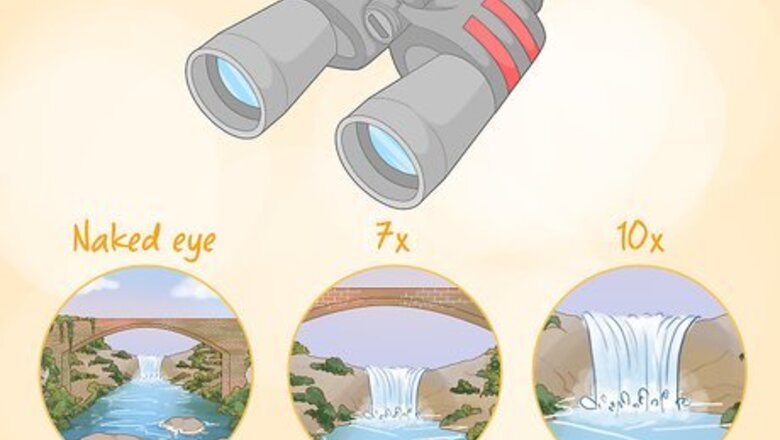
views
- Binoculars with a 7-10x magnification are best for general use. Higher magnifications can get closer to a subject, but the image quality won’t be as crisp.
- Consider what activity you’ll use binoculars for. If you’re sailing, you might want a waterproof set. If you’re stargazing, you might want a pair that can see at night.
- Binoculars with larger, glass lenses tend to be higher quality but they weigh and cost more too.
Types of Binoculars
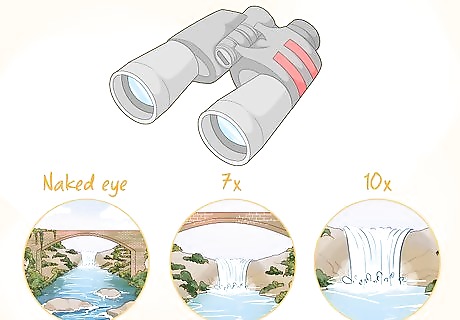
Choose binoculars with a 7x to 10x magnification for general use. Before buying a set of binoculars, look at the number that comes before the “x” in their description. This is the magnification factor, which dictates how much closer objects will appear to be. If you just want binoculars for general use, 7x to 10x magnification is usually your best value. Binoculars are referred to with 2 numbers, such as 7 x 35 or 10 x 50. The 1st number is the magnification and the 2nd number is the diameter of the front (objective) lenses in millimeters. For example, 7 x 35 lenses are 35 millimetres (1.4 in) in diameter, while 10 x 50 lenses are 50 millimetres (2.0 in) in diameter. While binoculars with small magnification factors produce images that are less enhanced, these images will be sharper and your field of view (how widely you can see) will be wider. If you need a wide field of view, such as for viewing a football game from high seats, choose binoculars with a lower magnification (7-8x).
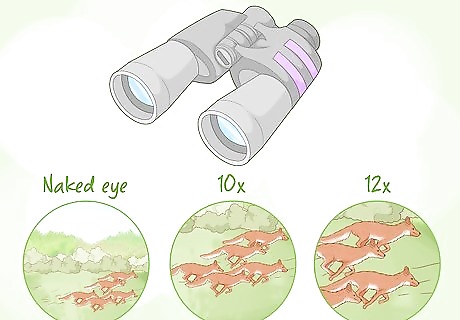
Look for high magnification for long-range hunting. If you’re hunting in the mountains or in wide open ranges, choose binoculars with larger magnifications, usually pairs in the 12x range. If you’re hunting in a heavily forested area, choose a set with a slightly lower (but still substantial) magnification. 10x pairs generally work best in the woods. The higher the magnification of your binoculars, the dimmer the image. Because your field of view will narrow, it’ll be harder to keep the picture focused. If you choose binoculars with 10x magnification or greater, get a tripod socket to mount and steady them.
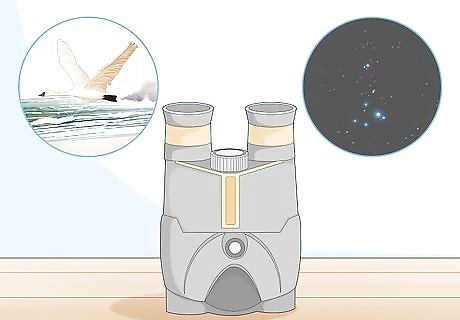
Prioritize larger lenses for bird watching or low-light activities. Binoculars with larger objective lenses have wider fields of view, which are better for finding and following birds when you’re bird watching. Larger lenses are also able to gather more light, which is important in low-light activities like night hunting. If you're interested in astronomy and stargazing, get a pair with large objective lenses (70mm is common) and low magnification so you can see vast, dim objects like nebulae and galaxies. If you’re more interested in seeing the details on smaller birds at greater distances, opt for binoculars with larger magnifications and smaller lenses. The larger the lenses are, the more the binoculars will probably weigh. Generally speaking, standard-sized binoculars have objective lens diameters larger than 30mm, while compact-sized binoculars have lens diameters smaller than 30mm.

Choose low-cost options for casual hobbies and pricier pairs for durability. Set a budget for your binoculars before buying. While the more expensive, top-of-the-line pairs will last longer and have higher image quality, there’s plenty of adequately durable options with solid optical quality for as little as 80 bucks. Find a reasonable price range for your binoculars based on your hobby and don’t go over it. Think about how you intend to use your binoculars; a pair you intend to keep at home to look out the window doesn't need to be as durable as a pair you want to take sailing with you.
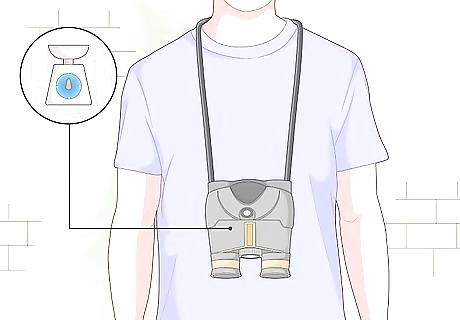
Choose lightweight binoculars for hiking, traveling, or carrying long distances. High-magnification and large-lens binoculars weigh more than standard binoculars. If you plan to travel long distances, don’t have a lot of storage room, or carry your binoculars around your neck, you may want to settle for less powerful, but lighter binoculars. You can compensate for the weight and stabilize the binoculars by mounting them on a tripod or with a strap that lets you carry them around your neck
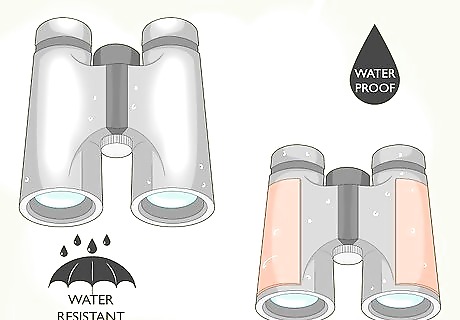
Consider waterproof and water-resistant binoculars. Some binoculars are made with water and fog-proof technology to get rid of moisture around the lenses. However, these are often more expensive and you may not need to spend that extra cash. If you don't plan on using your binoculars in bad weather conditions where they'll get wet often, just buy a regular pair. If you plan to take them along whitewater rafting or skiing, get water-resistant or waterproof binoculars instead.
Evaluating a Pair of Binoculars
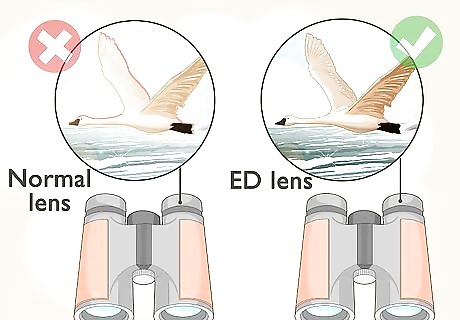
Choose glass lenses over plastic for better quality images. Most binoculars have glass lenses, which generally provide crisper images when you look through them. While these sets are more expensive, it’s worth the money if image quality is a high priority to you. Glass-lens binoculars made with Extra-low Dispersion (ED) glass produce the most high quality image. However, they’re also one of the most expensive types on the market. Glass lenses tend to reflect the light they capture, which can refract your image. Apply an anti-reflective lens coating every 2 years or so to prevent this. Some binoculars also come with a pre-applied (often permanent) coating. Lens coatings are described with the following codes: C means that only some surfaces have been coated with a single coating layer; FC means that all glass lens surfaces other have been coated; MC means that some surfaces have been coated with multiple layers; and FMC means that all glass lens surfaces have been coated with multiple layers. Multiple-layer coatings are generally superior to single coatings, but add to the cost of the binoculars.

Opt for plastic lenses for durability. Plastic lenses might not give you the most quality image, but they’re much more rugged than glass lenses. If you intend to use your binoculars outdoors and in rugged conditions where they might take some damage, choose a pair with plastic lenses. For example, binoculars with plastic lenses are the best choice for activities such as hiking and mountain climbing, or for children who are handling binoculars for the first time. Some plastic lens binoculars even provide the same image quality as glass ones. However, these are generally more expensive.

Ensure the eyepieces are comfortable to look through. The eyepiece lenses should rest an appropriate distance from your eyes, and even further if you wear glasses. This is called "eye relief" and normally ranges from 5–20 millimetres (0.20–0.79 in). If you wear glasses, you'll need an eye relief of 14–15 millimetres (0.55–0.59 in) or greater, as most eyeglasses rest from 9–13 millimetres (0.35–0.51 in) from the eye. Many binoculars include rubber eye cups around the eyepieces to help you seat them comfortably over your eyes. If you wear glasses, look for binoculars with eye cups that retract or flip out of the way.
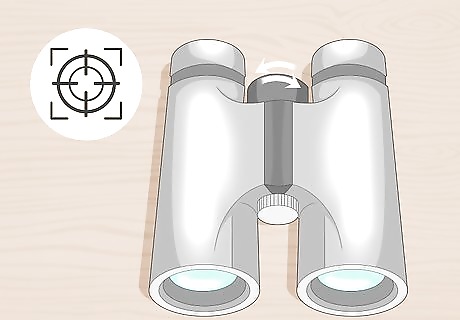
Test the focusing function. Before buying, calibrate a pair of binoculars inside the store to see how closely you can focus them on a nearby object. Measure the distance between the object and the binoculars to gauge the image quality for that particular length. Choose a faraway object if you care about spotting tiny details from large distances. To adjust binoculars to your eyes, close your right eye and focus your left eye on a distant object using the central focus. Then close your left eye and use the focusing ring on the right eyepiece to focus your right eye. This compensates for the difference in strength of your eyes. Binoculars focus in 1 of 2 ways. Most binoculars have a center-post mechanism, as well as a diopter corrector in case one of your eyes is stronger or weaker than the other. Waterproof binoculars usually have individual focusing for each lens, with controls on each eyepiece. Some binoculars are "focus-free," with no ability to adjust the focus whatsoever. These binoculars can cause eyestrain if you attempt to focus on something closer than the binoculars’ preset distance.

Look at the prism design to gauge how good the images will be. Most binoculars have their main lenses spaced wider than their eyepieces, thanks to the Porro prisms they use. This makes the binoculars larger, but makes nearby objects appear more 3-dimensional. However, some binoculars use roof prisms instead of Porro prisms, which let the main lenses rest in line with the eyepieces. This lowers the image quality, but makes the binoculars more compact overall. Less expensive binoculars use BK-7 prisms, which tend to square off one side of the image, while more expensive binoculars use BAK-4 prisms, which deliver more light and sharper, rounder images. Some roof prism binoculars create images at the same quality as Porro prisms, but they’re more expensive.

Check out the manufacturer's reputation and guarantees. Before buying, consider how long the binocular manufacturer has been in business and what other optical products they make. Also research their policies if the binoculars get damaged and what warranties they offer. Common green flags from manufacturers are at least 100+ positive online reviews, a warranty that covers repairs for your binoculars, and a clear history of making optical products (like cameras and eyeglasses).
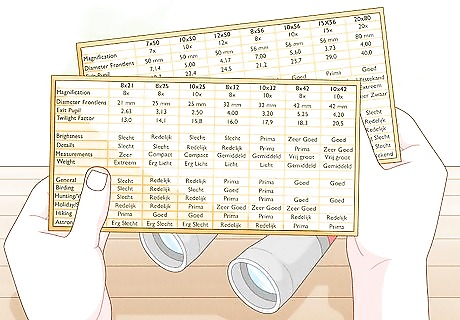
Use a magnification table to determine the right pair of binoculars for your hobby. Magnification charts compare and contrast the different sizes of binoculars and their lenses to determine which pairs are the most useful for which hobbies. For example, binoculars with larger lenses usually have great image detail, making them great for bird and whale watching. However, they’re heavy and difficult to carry so you probably don’t want to hike or paddle with them. Magnification charts also cover details like exit pupil size (the amount of light that comes through the eyepiece) and twilight factor (how effective the binoculars are in low-light conditions). 15 is usually the base score for a twilight factor. Anything lower means your binocs should probably only be used in daylight.


















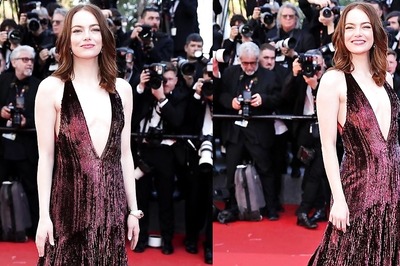
Comments
0 comment